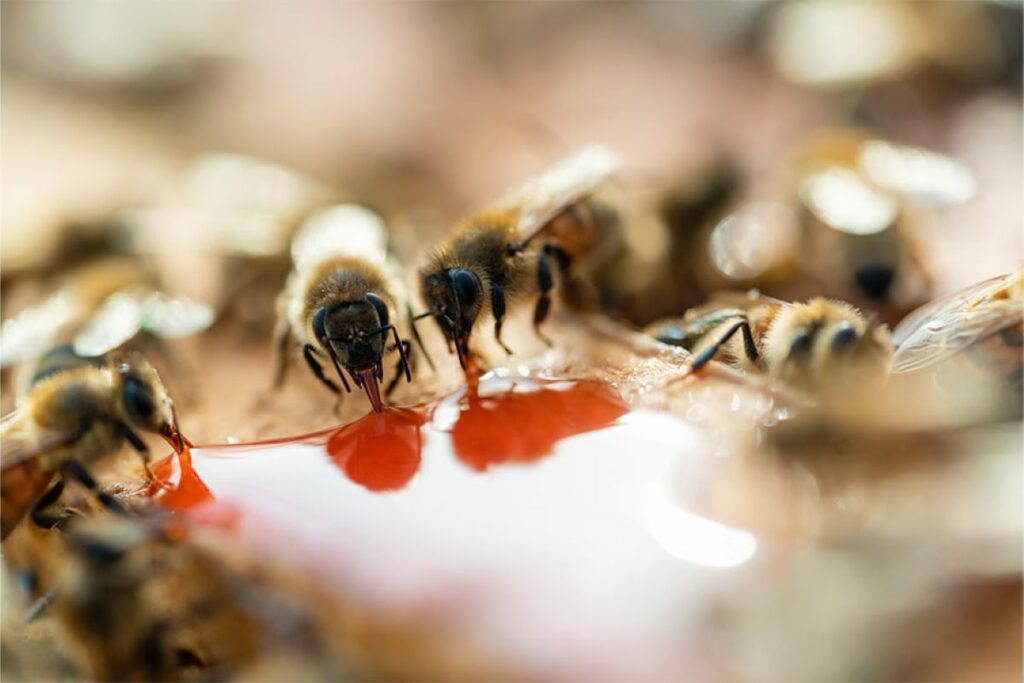5 Ways You Can Help Save Honey Bees
The honey bee is an integral part of the food chain — but its population has been declining rapidly. In fact, in the last few years, beehives have declined by 10 million.
So it’s up to all of us to do our part to save these crucial pollinators.
The impacts of Colony Collapse Disorder and the human destruction of bee habitats have caused untold damage to bee populations — and our world as a whole.
Every day is National Honey Bee Day to us, but to mark the official August 20 designation, we’re sharing a few simple ways you can help.

How to save honey bees
1. Become a beekeeper
Honey bees are one of the most important pollinators in our food supply. As honey bees suffer from population decline, we need more “beekeepers” to take up this rewarding hobby!
Beekeeping is inexpensive and straightforward — all you’ll need is an old-fashioned glass jar (or, even better, a used mayonnaise jar), a screw-top lid, and some “honey water.”
Honey water is an inexpensive way to feed your new bees — simply mix one teaspoon of Red Belly Honey with four teaspoons of warm tap water until dissolved.
Some beekeepers prefer to use frames made of wood, which you can buy or make at home. You’ll need a couple of pieces of untreated lumber along with some screws and nails to assemble the frame. The size depends on how many hives (or honeycombs) you want to manage — start small and work you way to a larger hive.
Lastly, you’ll need the bees themselves. You can contact a local beekeeper to purchase a colony of bees and learn how to sustainably and responsibly keep them.
As an added bonus, if left untouched by humans, they’ll produce honey in about six weeks.
2. Plant a bee-friendly garden
Planting flowers and herbs that will thrive in your area is a great way to encourage honey bee flourishing.
Plus, planting an herb garden with fresh basil, thyme, rosemary, chives, parsley, or mint means you’ll have some for cooking. You can also plant wildflowers — the perfect food source for bees’ pollination.
Some of the most attractive plants to bees and other pollinators include any type of clover, mint, lavender, orange daylilies, columbine, asters, or goldenrod as well as many species of sunflowers in the Helianthus genus.
3. Reduce pesticide use
Pesticides can be harmful to bees and other pollinators, as well as the environment. Using a natural approach to reducing pests in our gardens will help save honey bee populations and promote biodiversity among garden plants themselves.
Good alternatives for pest control include handpicking insects and their eggs from leaves, late-summer plantings of fragrant herbs such as thyme and rosemary, ladybugs (they’re natural predators for aphids!), or using nematodes to control soil-inhabiting pests.
4. Avoid using nonstick pans
Did you know one of the best ways to protect honey bees is to change up how you cook? Nonstick pans can release toxic chemicals called polyfluoroalkyl substances (PFAs) into the air when heated.
When these PFAs are released, they can be inhaled and absorbed by honey bees before eventually settling on plants that pollinators visit for food or water.
Research shows these chemicals can affect a bee’s ability to navigate back home, make new queens, or produce enough worker bees for their hive. PFAs have been linked to declines in honey bee populations and other pollinators like bumblebees and butterflies.
5. More honey means more hemp = more bees
The number one way to help save our furry best friends? Buy Red Belly Honey — we’re helping bees live longer. It’s true — our bees drink plenty of hemp terpenes.
Terpenes are the compounds responsible for the way most plants smell, FYI. They’re abundant in cannabis/hemp and many other plants, fruits, and herbs.
But hemp terpenes are special — they’re known to protect the human nervous system, and now a new published study confirms hemp terpenes also protect bees.
These terpenes protect the bees’ antioxidant system — helping them fight off pesticides. Bees that have access to hemp terpenes are able to fight off the pesticide poisoning and live as long as bees that have never been exposed.
That means bees are living longer, multiplying faster, and breaking off from our hives to create more hives in the wild. Red Belly Honey is literally adding bees to the planet!
So it’s simple — the more honey we sell, the more hemp nectar we make, and the bees get more, to make more honey.
If it has to do with helping humans feel better and bees live longer, it has to do with us.












